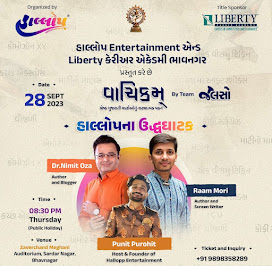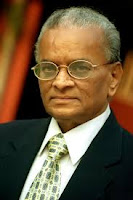On the evening of September 28, 2023, I had the privilege of attending “Vachikam,” a mesmerizing dramatic reading of renowned Gujarati stories, brought to life by the talented Jalso team. This captivating event was meticulously organized by Hallopp Entertainment, marking its debut in the world of entertainment.
The show started at around 9:30 pm. First, there was an inauguration ceremony. Then we heard about the inspiring journey of Mr. Punit Purohit, who is the founder of Hallopp. Mr. Purohit shared his profound connection with the word “Hallopp,” explaining how it ignited his motivation, evolved into his life’s mantra, and eventually became the name of his firm.
Dr. Nimit Oza, a renowned author and influential blogger, took the stage, delivering a powerful and thought-provoking speech. Among his many pearls of wisdom, he unveiled the three essential “P’s” that pave the path to success: Passion, Perseverance, and Patience. His words resonated deeply with the eager audience, leaving them inspired and contemplative.
Adding to the evening’s allure, Gujarati Author and Screenwriter, Ram Mori, graced the gathering with his encouraging words, setting the stage for the main event. As the curtains rose and the dramatic readings began, it was evident that “Vachikam” would be an unforgettable experience, a testament to the creativity and talent that thrives in the world of Gujarati literature and entertainment.
The first story that was read was Odipo by legendary writer Jhaverchand Meghani. It was the story of loving and hard-working Rupi. She happily lived with her in-laws and was fond of decorating her home. She was so skilled in this task that it evoked jealousy of village-people. Once, she visited her mother on some occasion but due to some misunderstanding, Rupi’s mother forbade her to go back to her in-laws and tried to marry her off somewhere else. Rupi was not able to accept this and waited for her husband. However, when no hope was left, she jumped in a river and ended her life, as she would rather die than live without her husband. The sad tale of Rupi was narrated with such skill that it brought the audiences to the verge of tears.
Next was an enchanting story by Himanshi Shelat called “Sundar, Amruta ane Vruksh”. Speaker Mr. Naishadh Purani claimed this to be one of his favourite story. Sundar is a talkative fellow who meets the unnamed narrator. He instantly becomes friends with him and invites him home. Sundar also describes “Amruta” his wife, in an alluring method, which sparks our narrator’s imagination. After meeting a few times and a few more invitations, narrator visits his home. However, all is not as he expected and narrator leaves in a hurry. At the end, Sundar feels bad as nobody wants to see the tree, in his backyard, which he keeps talking about.
Then we heard, “Ambagorani No Parbhudo” by Chunnilal Madiya. It was the story of an old mother, the titular character Amba Gorani, who has to witness the painful ordeal of her son Parbhu’s attempted suicide. The story takes place in a hospital where doctors are trying their best to save Parbhu. Amba Gorani is present there with some other people from the village. When it was apparent that Parbhu will not live longer, Amba Gorani only wanted to ask him one question. This one question entertained the people from the village as everyone started to guess what it would be. Some of them were shocked that how can Amba Gorani be satisfied in only one question, as Parbhu was her only family member. She was very old and it was thought-provoking how she can even accept her son’s death. Some of the villagers, very insensitively, cracked jokes on the family’s poverty. Some saying that she might want to ask to whom they do not owe any money so that she can ask for a loan. At the end of the story when that one question was revealed, everyone, characters of the story and the audience, were beyond sad. It was truly one of the saddest stories i have ever heard.
In story number 5, we met “Intellectual Indubhai”. Written by very talented Mahendrasinh Parmar (who was present in audience). In this story, we explored the differences between a pretentious intellectual, who only wants to “look” intelligent and a real one, someone who actually understands things. Indubhai was a true intellectual. We see how he struggles with intelligence and suffers the consequences of other’s misdeeds. As a reader, the fire at Indubhai’s house brought tears to my eyes. He’s a college professor but as he witness his students becoming a part of illogical chaos, he is deeply hurt. This hurt and helplessness transform the intellectual Indubhai to some mad person who sees Milton on the streets.
Then we enjoyed the special performance of Deep Vyas who presented “E..E..Eso”, a story which he wrote himself. It was a brilliant story about Eso who could not see properly but had a very proper perspective.
We ended this wonderful evening with a story, written in letter format, by Kundanika Kapadiya. This thought-provoking piece was “Sampurna Sundar Pane”. It was about a woman who got divorce after 12 years of marriage and was writing the last letter to her ex-husband. It was about hope of new beginnings and strength to leave behind the past.
I would urge all my readers to experience these stories yourself on the Jalso app. I would like to thank the Jalso team for their entertaining performance. My heartfelt thank you to Hallopp Entertainment for organising this memorable event. Last but not the least, I would like to thank my wonderful teacher Vaidehi Ma’am for sharing about this awesome event. It was truly an unforgettable evening.










































